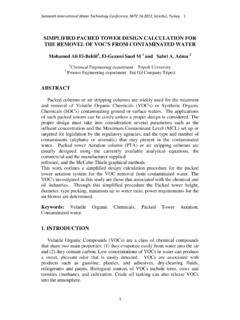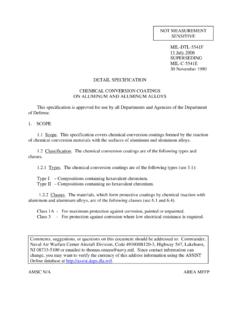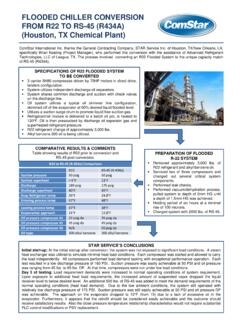Transcription of OVERVIEW ON CHEMICAL OXIDATION TECHNOLOGY IN …
1 Ninth International Water TECHNOLOGY Conference, IWTC9 2005, Sharm El-Sheikh, Egypt 115 OVERVIEW ON CHEMICAL OXIDATION TECHNOLOGY IN wastewater treatment 1I. G. Rashed a*, M. A. Hanna**, H. F. El-Gamal*, A. A. Al-Sarawy* and F. K. M. Wali * * Mansoura Faculty of Engineering and ** Damiatta Faculty of Science, Mansoura University, 35516 Mansoura, Egypt ABSTRACT Many industrial activities utilize organic compounds as a key CHEMICAL in organic synthesis of special chemicals such as, synthetic resins, paper products, medicinal products, drugs, dying and others. Different CHEMICAL processes, most of them based in OXIDATION -reduction reactions, are being applied. Processes such as chlorination, ozonation, UV irradiation, electrochemical treatments and processes based in OH. radical attack have been investigated looking for the the best effectiveness to eliminate these toxic soluble substances.
2 Most of these treatments have proved worthy in this field, achieving good results in the destruction pollutants. Also must of these researches in this field have been focused in the mineralization of pollutants. Due to the increasing interest in developing alternative methods for improving the treatment of wastewater containing organic pollutants, advanced CHEMICAL OXIDATION technologies (AOTs), was applied for destruction of some organic compounds from their aqueous solutions and from industrial wastewater containing them. This review focuses on different OXIDATION technologies which can be used for destruction of organic pollutants. Advanced CHEMICAL OXIDATION TECHNOLOGY applications help in the elimination of environmentally hazardous waste. This article is concerned especially with advanced CHEMICAL OXIDATION technologies and the application of "Fenton OXIDATION " as a practical example for this TECHNOLOGY (AOTs) for removal of organic pollutants from wastewater .
3 Key words: Advanced CHEMICAL OXIDATION technologies (AOTs), Fenton reaction, Destruction of organic compounds, Hydrogen peroxide and hydroxyl radical. a To whom all correspondence should be addressed Ninth International Water TECHNOLOGY Conference, IWTC9 2005, Sharm El-Sheikh, Egypt 116 INTRODUCTION The appearance of compounds that are difficult to degrade by conventional CHEMICAL and/or biological methods (toxic, mutagenic, carcinogenic pollutants) in natural waters recently created a pressing need for the development of efficient water- treatment processes. The search for a solution to this problem has involved extensive examinations in the field of advanced OXIDATION processes (AOPs). In CHEMICAL OXIDATION processes, reaction mechanisms change structure, and CHEMICAL properties of the organic substances.
4 Molecules break in smaller fragments; higher percent of oxygen appears in these molecules in form of alcohol's, carboxylic acids etc. OXIDATION of organic compounds with OXIDATION such as ozone or OH. radicals usually yields more oxidized ones which are in most cases more easily biodegradable than the former ones. This is the general idea that yields to the combination of a CHEMICAL OXIDATION processes. OXIDATION with ozone or hydrogen peroxide has been found to be an important alternative to chlorination, because the OXIDATION does not result in toxic chlorinated organic compounds [1, 2]. Advanced OXIDATION Technologies (AOTs), including Advanced OXIDATION Process (AOPs) and other physicochemical conversion methods which are [1]: (1) Advanced OXIDATION Process (AOPs), (2) Non-Thermal Plasmas (NTP) for air and wastewater treatment , (3) Electrohydraulic cavitation and sonolysis for wastewater treatment , (4) Electron beam and gamma-ray irradiation, (5) Catalytic OXIDATION for air treatment , (6) Wet air OXIDATION for wastewater treatment , (7) Supercritical water OXIDATION treatment , (8) Electrochemical redox reactions for wastewater treatment and (9) Photocatalsis for wastewater and air treatment .
5 (1) Advanced OXIDATION Process (AOPs): The concept of advanced OXIDATION process (AOPs), was defined by Glaze et al. [13] In 1987 as processes that involve the generation of hydroxyl radicals in sufficient quantity to affect water purification . In this context, advanced OXIDATION processes generally mean the application of either OXIDATION technologies using UV/O3, O3/H2O2, UV/ H2O2 or the photo Fenton reaction (UV/ H2O2/ Fe++ or Fe+++) [1]. Peyton [3] gave a detailed OVERVIEW and description of AOPs in 1990. The advanced OXIDATION process (AOPs) will discussed in details after mention of the rest advanced OXIDATION technologies (AOTs). (2) Non-Thermal Plasmas (NTP) for Air and wastewater treatment Non-thermal plasma TECHNOLOGY (NPT) [4] is a new advanced OXIDATION TECHNOLOGY , which is applied to treat air pollutant [5] and may also be applied to treat wastewater [6].
6 The plasma produced by an electron beam, a pulsed corona discharge or a dielectric-barrier discharge employed to create a large quantities of high reactive free radicals (mainly atomic oxygen in the ground energy state (O3P) and oxygen in the Ninth International Water TECHNOLOGY Conference, IWTC9 2005, Sharm El-Sheikh, Egypt 117 first excited energy state (O1D) [7] , and hydroxyl radicals) in a gaseous medium at near ambient temperature. These radicals subsequently react with entrained hazardous organic chemicals, converting them to either nonhazardous substances (CO2, H2O and acids, , mineralized compounds) or other easily manageable compounds. Because NTP processes can simultaneously remove or convert different types of pollutant, , volatile organic compounds and oxides of sulfur and nitrogen frequently found in flue gases, it is particularly attractive for many present and future environmental applications [8].
7 The mechanism of OXIDATION of SO2 and NO by NTP [5, 9 and 10] in a gas phase also containing H2O is given as an example. First we have: O2 O(3P) + O(1D) 2 .OH (1) H2O H. + .OH (2) The oxygen atoms (O.) produced in different energy states shown in Equation 1) and hydroxyl radicals can react with SO2 to form H2SO4 , and can react with nitrogen oxides to form HNO3 : SO2 + O. SO3 (3) SO3 + H2O SO3 (4) SO2 + .OH HSO3 (5) HSO3 + .OH H2SO4 (6) NO + O. + INERT NO2 + INERT (7) NO2 + .OH HNO3 (8) where INERT is any available third compound (usually N2 or O2), which is a chemically inert molecule in the reaction meant to stabilize the reaction product [11]. the final product H2SO4 (Equations 4 and 6) forms liquid droplets, while the gaseous reaction product HNO3 (Eq.
8 8) can be removed by the injection of NH3 or Ca(OH)2 resulting in NH4NO3 and Ca(NO3)2 , respectively. H2SO4 droplets and particles of NH4NO3 can be remove from the gas stream by using scrubber or an electrostatic precipitator. (3) Electrohydraulic Cavitation and Sonolysis for wastewater treatment Electrohydraulic cavitation involves the formation and behavior of bubbles in liquids [12, 13]. It is induced by applying electrical power is provided by a pulse-powered plasma discharge producing pulsed and/or continuous ultrasonic irradiation ( , sonolysis) in water. Kinetic and sonoluminescnce measurements indicate that an extremely high temperature (>500 oK) and pressure (>100 atm) are generated during the adiabatic and short-time (<1 s) implosions occurring at the cavitation sites.
9 When a bubble fills with gas and vapor pulses and collapses, molecules inside the bubble or close to the bubble surface is fragmented, escape into the bulk of the solution and react in various ways outside (or inside) the bubble [14, 15]. In this situation, water or pollutants split into radicals as shown in Equations 9-11. H2O H. + .OH (9) CCl4 . CCl3 + Cl. (10) e Ninth International Water TECHNOLOGY Conference, IWTC9 2005, Sharm El-Sheikh, Egypt 118 H2S H. + HS. (11) After the production of these radicals, pollutants such as tetrachloromethane and hydrogen sulphide in the water can be oxidized to final products such as CO2, Cl- and SO42- [16-18]. (4) Electron Beam and Gamma-Ray Irradiation High-energy electron beams are gamma rays ( , ionizing radiation) are very effective tools for water pollutant degradation.
10 The development of new powerful electron accelerators ( , an energy level of MeV and a power level of 50 KW, or an energy level of MeV and a power level of 400 KW) enables very effective radiation processing of wastewater streams [19]. when a high energy electron beam of gamma ray irradiates water, the water (as well as organic compounds contained in it) split into a number of primary species of eaq (electrons in aqueous solutions), H., .OH, H2, H2O2, H+ and OH-. Some of these primary species then colloid with other substrates in water to form more radical species that are oxidants and therefore able to oxidize organic pollutants [20, 21]. As has been observed when using this TECHNOLOGY , many organic compounds can be promptly oxidized such as polychlorinated biphenyls (PCBs) [22-24].













